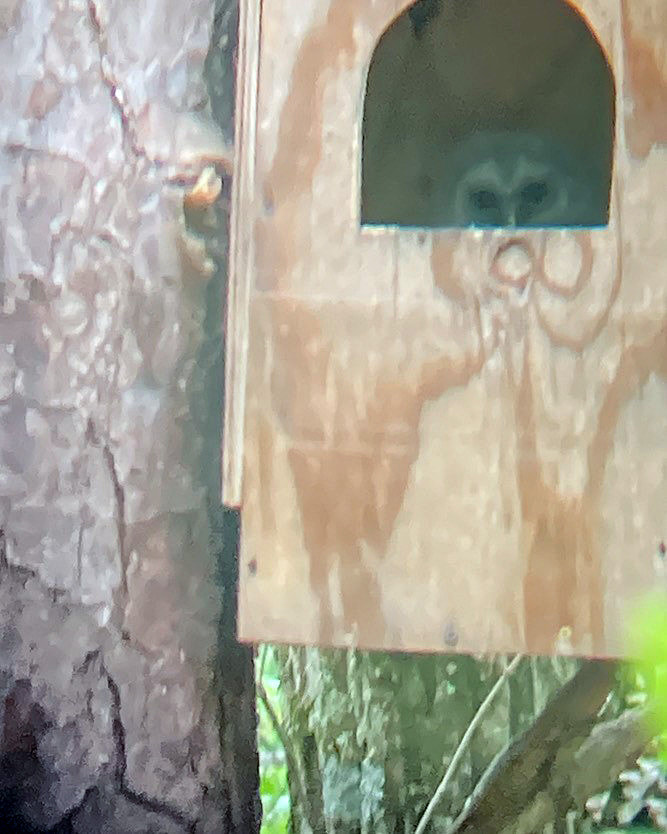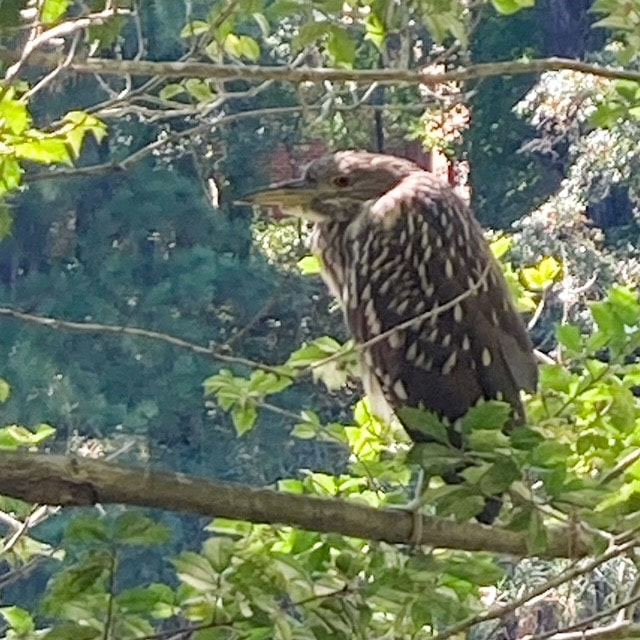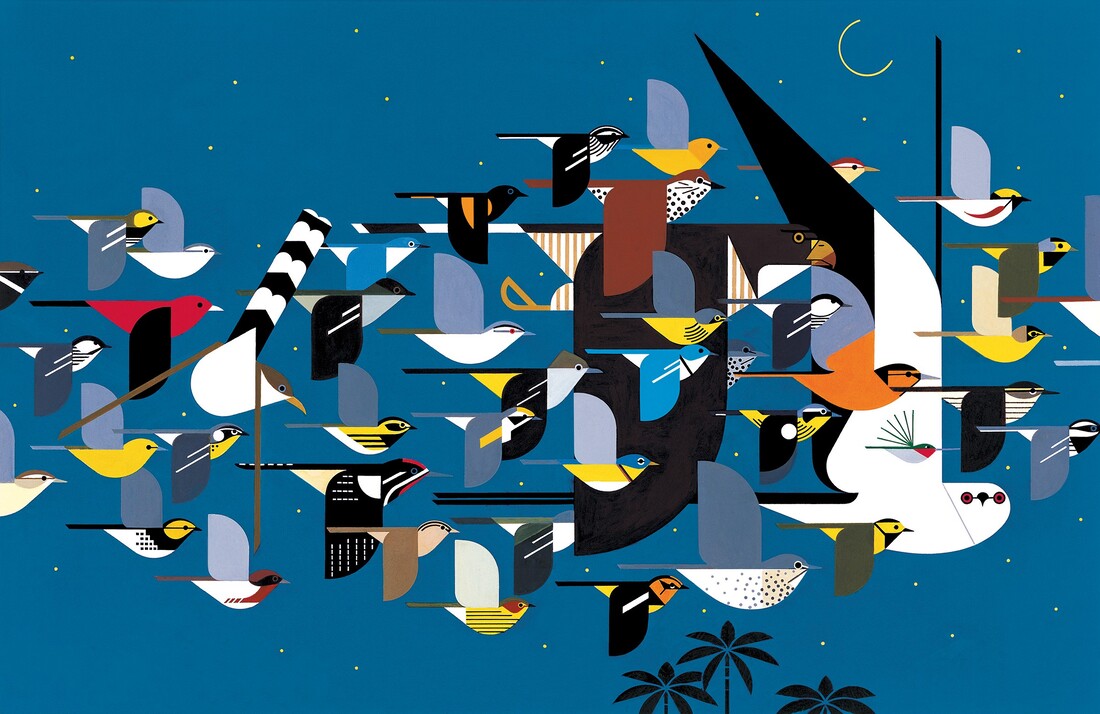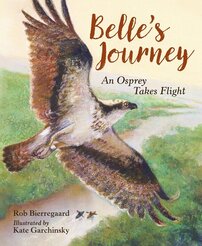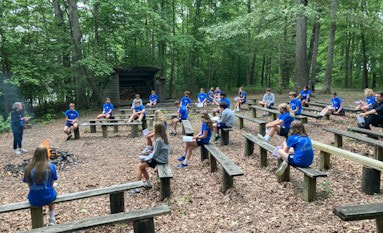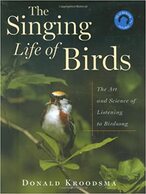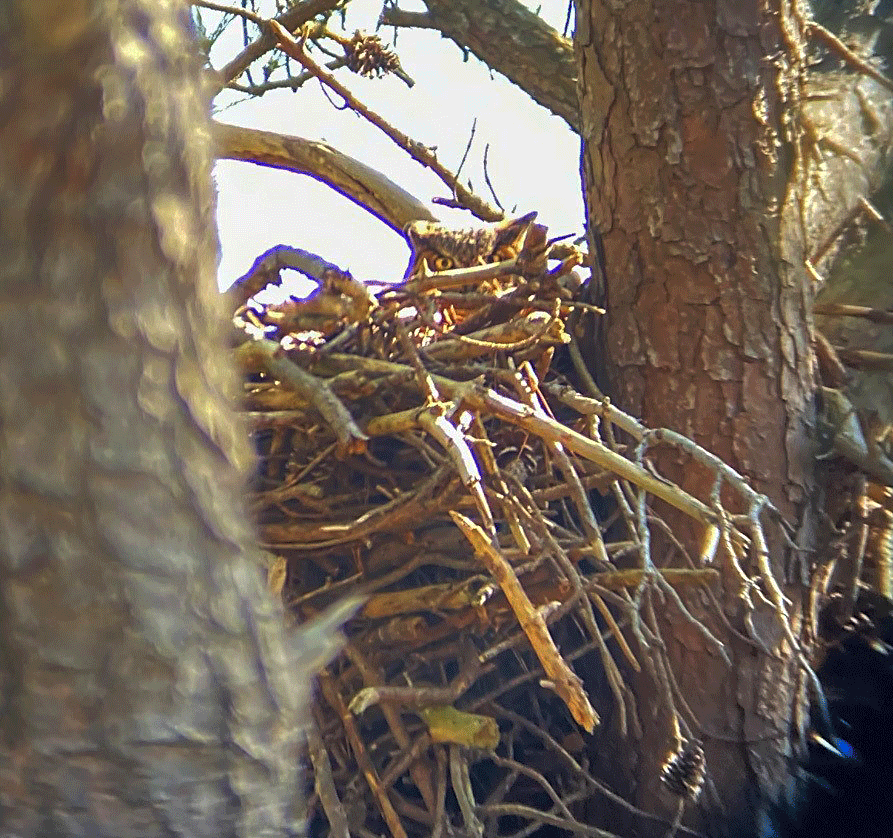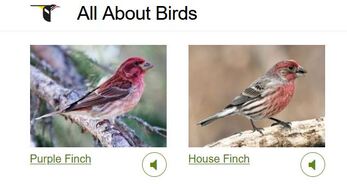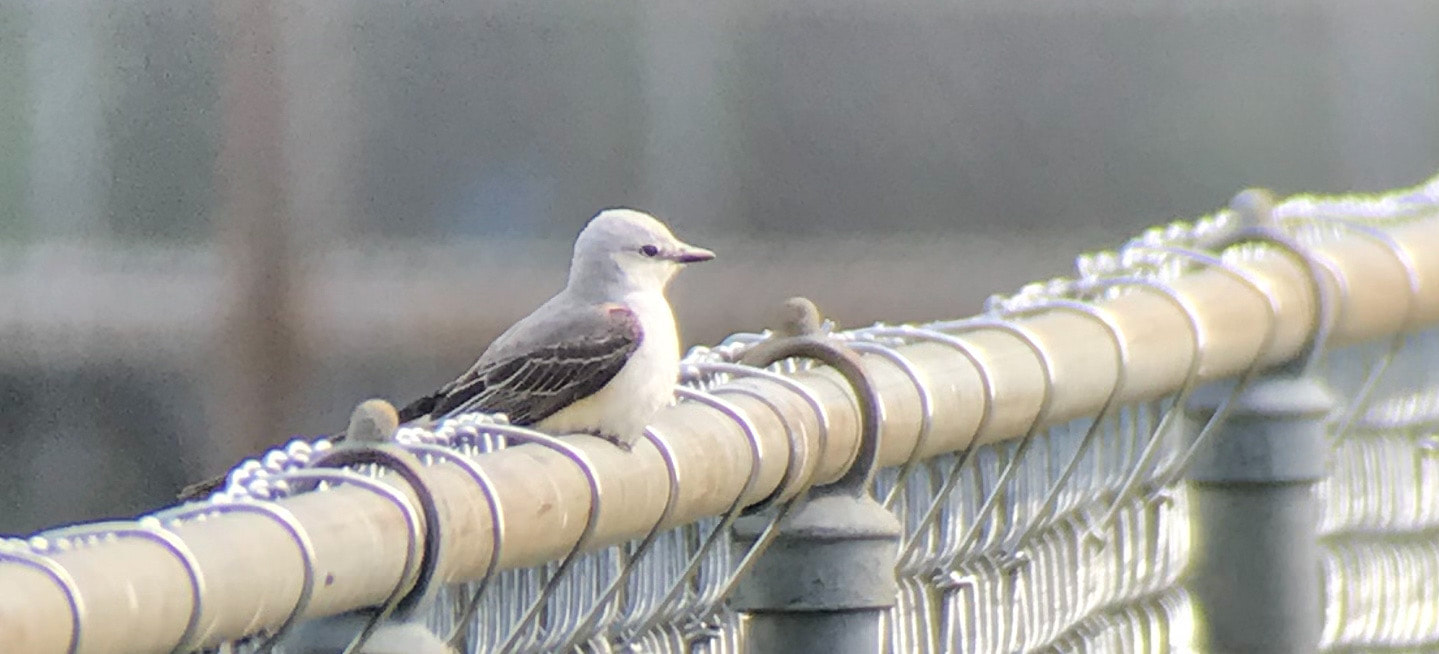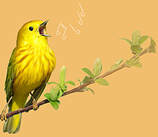St. John Eagles
|
Bird Club is typically offered in the spring of each year, during the migration of many songbirds and the time of setting up territories and nesting. Depending on AM times to meet before school, it is offered to students in grades 4-7, in limited numbers for practical reasons.
April 11, 2024
|
Bird Club 2024 - A Successful Start!
Eleven club members, plus Father Jeremy Smith, ventured out to our woodland trail for our first hike of the spring. We had nice weather and we saw and heard several species. I always emphasize the importance of learning to use our ears during 'bird-watching,' since it is very helpful to find the birds calling in your immediate area, and to even identify them without seeing them as one learns their vocalizations. One of the observant students spotted a few birds flying up high (north, over 400 feet up). As I got my binoculars on one of them I heard the call of the Common Loon! A common migrant this time of year, but more easily seen on or over the Bay; this was a fun sighting, and the first time I have seen that species from this property. I now have seen or heard 105 species of birds from the St. John property. The highlight of the morning was Red-bellied Woodpecker. We first heard one, and listened to samples of the call on a phone app. Then we saw it go into a hole on an upright, but dead, pine tree. We all got a look at it as it perched with its head and shoulders protruding from the hole off and on for a few minutes… a likely nest hole. I used the Merlin app on the woodpecker call to demonstrate identifying birds by calls. Most of the students have used this app with me previously. Other species seen or heard include American Crow, Blue Jay, Northern Cardinal, American Goldfinch, Tufted Titmouse, American Robin, and Eastern Bluebird. |
May 17, 2023
|
Early Morning at Kinder Park Farm
We had a nice morning for our last bird club gathering at Kinder Park. We ended up with over two dozen species either heard and/or seen. Highlights included looks at male and female Eastern Bluebirds, including one carrying nest building materials (bottom image), a male Indigo Bunting, a pair of chickadees, mourning doves, and a few others. We heard (and some saw) Black-throated Green Warbler (middle image), Blue Jay, Red-eyed Vireo, Downy Woodpecker, Carolina Wren, and Yellow-billed Cuckoo (top image). There were calls from Brown-headed Cowbird, Cardinal, Swainson’s Thrush, Goldfinch, Pileated Woodpecker, Blue-gray Gnatcatcher, Tufted Titmouse, Red-bellied Woodpecker, Great Crested Flycatcher, and Bobolink. Kinder Park has a variety of habitats and plenty of acreage, and it’s likely that a day spent there from 6 AM -11 would probably get about 50 species this time of year, if you can identify calls/songs as well as seeing them. We had several great morning hikes this spring. I hope all the students learned to appreciate the variety of birds we saw, and heard, and are inspired to learn to find and identify more birds by their field marks and their vocalizations! I had a great time, as I always do when bird watching/listening! To help those who want to better enjoy bird calls, here is a link to an 8-part series of articles from National Audubon on how to learn birds songs and other vocalizations. |
May 10, 2023
|
Bird Club Hike - With a Nice Finish!
We had an interesting hike in beautiful weather conditions on school property this morning, with calls/songs heard from many species including migrant species such as Ovenbird, Red-eyed Vireo, Great-crested Flycatcher, and Red-winged Blackbird. We also heard year-round residents including White-breasted Nuthatch,Tufted Titmouse, Carolina Chickadee, Carolina Wren, Downy Woodpecker, and Blue Jay. In addition, many of us saw, and sometimes heard, American & Fish Crow, Mourning Dove, Mockingbird, Northern Cardinal, Red-bellied Woodpecker, Veery (type of thrush) and Common Yellowthroat (a small warbler). Highlights of the day bookmarked these other species. Early in the walk we again got a good look at the baby Barred Owl still in the nest box that was mounted in our woods about 4-5 years ago. Before long it will emerge and soon after start flying and continue begging for food from its parents for several months. At the end of our walk we heard the loud call of our largest woodpecker in North America, the Pileated Woodpecker. We thought we might see it flying above us in the woods, but that did not happen. However, just after that one of the students spotted a Scarlet Tanager not far from us, and not high in the canopy of the trees as is often the case, but only about 20 feet above the ground. Watching the tanager, it eventually flew to a nearby area where there were 3 or 4 other brilliant males and at least one female also foraging not far from us and not far above the ground, esp. for a tanager! In 40 years of bird watching I don't ever remember such good looks at a group of tanagers. |
April 5, 2023
|
Bird Club 2023
Eight members of our club, plus Fr. Ponton, gathered today for our first hike on school property. We first took a brief look at an excellent web site to monitor bird migration on a daily (actually, nightly) basis, called BirdCast. It showed that there were movements of migrants into the mid-Atlantic last night, though it was fairly light here. Great weather and calm winds allowed us to observe many species (~25), especially in our woods. At least one group member, usually most, saw or heard these species: Mallard Duck Double-crested Cormorant, Downy Woodpecker, Red-bellied Woodpecker, Common Flicker, American Crow, Blue Jay, Carolina Chickadee, Tufted Titmouse, White-breasted Nuthatch, Ruby-crowned Kinglet, Carolina Wren, Eastern Bluebird, Hermit Thrush, American Robin, House Sparrow, House Finch, American Goldfinch, Chipping Sparrow, White-throated Sparrow, Song Sparrow, Red-winged Blackbird, Brown-headed Cowbird, Pine Warbler, and Northern Cardinal. We discussed how most of these species are here year-round (residents), some are here mostly during the 'winter season' and will leave for the north soon (Hermit Thrush, White-throated Sparrow, Ruby-crowned Kinglet), and some have arrived recently from the south for their spring migration. (Pine Warbler, Brown-headed Cowbird, Red-winged Blackbird). |
Nov. 13, 2022
|
Elk Neck State Park
I was able to take time to visit Elk Neck State Park for the first time (long overdue). Since this peninsula in the upper Bay is 'pointed' south, the southern tip of the park in particular serves as a temporary 'trap' as birds migrating south suddenly find themselves looking at the wide expanse of the upper Bay instead of more land to fly over. As a result, fall bird migration, especially from mid September - October is generally very good for both songbirds and raptors. The small group birding group I was with braved the colder and windy weather to see about 40 species, including several Bald Eagles, Red-tailed, Red-shouldered, Sharp-shinned and Cooper's Hawks, along with wonderful views of the upper Bay. |
Nov. 5, 2022
|
Hawk Banding
I went with my wife and a few birding friends to a banding station over the weekend and had a chance to see a few species up close and personal. I even has the chance to hold a few of the species, including the Red-tailed Hawk seen here and a Cooper's Hawk. |
Nov. 2, 2022
Raven at St. John
Up until 2010, Common Ravens were very rarely seen in Anne Arundel County (though they were being seen in counties west of here). Starting around that time they began to be seen in the county, and those sighting have become more frequent in recent years. They are now being seen often near the Bay Bridge, and for the last several years have been seen periodically in Queen Anne's County on the other side of the bridge.
This week, during an environmental education class near the rectory, a raven flew just a bit over treetop level for a few moments, the first time I have seen one here at St. John! Of course, American Crows, and even Fish Crows, close relatives, are common in Severna Park and the throughout the county, but raven sightings are still very notable.
Up until 2010, Common Ravens were very rarely seen in Anne Arundel County (though they were being seen in counties west of here). Starting around that time they began to be seen in the county, and those sighting have become more frequent in recent years. They are now being seen often near the Bay Bridge, and for the last several years have been seen periodically in Queen Anne's County on the other side of the bridge.
This week, during an environmental education class near the rectory, a raven flew just a bit over treetop level for a few moments, the first time I have seen one here at St. John! Of course, American Crows, and even Fish Crows, close relatives, are common in Severna Park and the throughout the county, but raven sightings are still very notable.
Sept. 21, 2022
|
Unusual Campus Visitor
This morning I was checking out our woodland trails with our maintenance staff, and while down near Cypress Creek we came across a juvenile Black-crowned Night Heron. They are around the bay area, but often go unnoticed. This one was just above eye level in a tree along the water's edge. A very interesting bird, adult or otherwise, and the first I have seen here at St. John. |
May 15, 2022
|
Hawkwatch
One of the more unique activities as a bird watcher is to visit one of the official hawk watch locations in the U.S. We have one nearby at Ft. Smallwood Park, an Anne Arundel County park. Many species of raptors migrate northward through Maryland in the spring, and at Ft. Smallwood Hawkwatch they have been collecting daily spring migration data for decades. I stopped by for a few hours Sunday afternoon, and as the weather improved, we had some nice sightings. Visitors are welcome, and other bird watchers and curious hikers often stop by to see what is going on and maybe learn a bit about our migrating birds of prey. Two famous autumn hawk watches are not too far away, and I have enjoyed both very much when visiting these sites. I most recently went to Hawk Mtn. in Oct. of 2020. Hawk Mountain Cape May Hawkwatch |
Broad-winged Hawk, via iStock
|
May 11, 2022
|
Bird Club Morning Walk
This morning we had our 3rd meeting of the St. John Bird Club. We started in the computer lab where I introduced BirdNet, a mobile app that can help identify bird calls that are recorded live, using the mic on a phone. We also took a look at Birdcast, a great site for current bird migration information. We then took our hike, including to the highest spot on our property, overlooking the tidal creek. It was at that spot where we stood quietly for about 10-15 minutes. While there we had a good look (and listen) to a Red-shouldered Hawk. I have seen them often, over the years, on our property, starting in 2009, from the parking lot, to soaring and calling high over campus, to hanging out on the soccer and lacrosse goals in the fields, to flying in the woods. Like Barred Owls, which also use our property, they prefer low, wet woodlands. We also heard red-eyed vireo, parula warbler, blackpoll warbler, yellow-rumped warbler, american crow, cardinal, blue jay, blue-gray gnatcatcher, hairy woodpecker, carolina wren, carolina chickadee, brown-headed cowbird, red-bellied woodpecker, and robin. Some of these were seen by members of our group. I also heard common yellowthroat, catbird, black and white warbler, and goldfinch. Just as we were finishing up I heard an interesting call, and using the BirdNet app, the group identified it as a Summer Tanager 'chatter call.' That is the first time I have heard one this year, the first time I have ever had one here at St. John, and the 99th species I have heard or seen on the St. John property. A few of us got to see it high above us where they prefer to feed and nest. |
Red-shouldered Hawk, via Birdshare
Summer Tanager, via Birdshare
|
May 9, 2022
|
Birdcast: Very Helpful Migration Information
I regularly visit this web site during the spring migration season, as it provides excellent predictions and results regarding bird movements. With the terrible weather this past weekend, birds were blocked from migrating through the east coast for several days (see image below). Hopefully by Wednesday of this week the prevailing winds and weather will allow birds to again migrate along the coastal states. |
May 4, 2022
|
Bird Club Morning Walk
Today we had our 2nd meeting of the St. John Bird Club. It rained overnight, but by the time we went our around 7 AM, the rain had stopped and there was little wind. We talked about how since birds are warm-blooded, they need to maintain their body temperature by regularly getting more food. During migration season that is even more of a necessity, as they use extra calories as they travel long distances and eventually start to defend territories and sing for long periods of the day. We had about two dozen species that we heard and/or saw, including the woodland Red-eyed Vireo. Most of the group got binocular looks at Gray Catbird, Carolina Wren, Northern Parula, and Tufted Titmouse. We listened to songs/calls of these and the other birds of the morning. |
Red-eyed Vireo, by Joe Carey, via Birdshare
|
May 28, 2021
|
Osprey: The Chesapeake Bay Summer Hawk
Probably most all of us are pretty familiar with Osprey (fish hawk). This migratory raptor typically arrives from the south in March, and heads back south during the fall months. Osprey commonly build prominent nests on trees and man-made platforms, and they very often sound out their plaintive calls from above as they call to their mates, search for food from waterways, and soar on rising thermals of warm air. It is the only raptor species found on six continents. What is important to remember is that just a few decades ago, the osprey, and other hawk species, were in danger of being wiped out by a agricultural chemical called DDT. It is a great example of people responding to a call for action to undue the harm done to many species of animals by the use of a chemical produced by people. Of particular note is the writing of Rachel Carson, author of Silent Spring. |
|
May 25, 2021
|
8th Grade Retreat at Camp Letts
Today was set aside as a special day for the 8th grade, and each homeroom spent half of the school day at Camp Letts in Edgewater, MD. Much of that time was outdoors, doing a variety of fun activities culminating in a campfire prayer service. Not only is it pretty quiet, bordered by water on three sides, and perfect for forgetting your cares, but its variety of woodland, water and field habitats make it a great spot for many birds also. A bonus bird was the Blue Angels, who flew over a few times for 'practice day.' While participating in the activities, I had a chance to listen to bird songs and watch for any birds (no binocs) near us during the morning. |
May 22, 2021
|
Birds Named for Their Songs or Calls
Like all species, birds have a scientific name, in Latin, for classification. For example, the Blue Jay, a common bird in our area, is classified as Cyanocitta cristata, which means a 'crested, blue chatterer.' Birds also have one or more Common Names, those they are usually known by, such as, well,... Blue Jay. Some birds have a common name based on 'something they say,' a song or a call. People gave the bird its common name because to them it sounded like the bird was saying those words. Many field guides describe the different words or phrases it sounds like a bird is saying to help recognize the vocalization, and remember the bird. I am providing a few of my audio files here of birds like this that I have heard or seen recently (the bird's name-word or phrase is in bold/italic): the tail-wagging Eastern Phoebe, the wood's Eastern Wood Pewee, the suburban Carolina Chickadee, the field's Northern Bobwhite, and the ground-feeding Eastern Towhee (with a bonus 'Drink Your Tea' at the end). |
Eastern Phoebe
|
May 14, 2021
|
Bird Drawing Tips from a Master
Without a doubt, I can use any help I can get when drawing an animal, such as a bird. One of the best known and widely respected bird illustrators today is David Allen Sibley, author of many books on birds, including his best selling Sibley's Guide to Birds. He has spent a lifetime studying and drawing birds. The National Audubon web site provides a page with tips and videos for drawing a nice variety of birds, large and small, narrated and demonstrated by Mr. Sibley. It's very helpful for those hoping to draw these feathered friends. https://www.audubon.org/magazine/summer-2020/learn-draw-birds-david-sibley |
...by David Allen Sibley
|
May 12, 2021
|
Birds Active Today on our School Trail
Sometimes birding is mostly a matter of luck ... my preference on a spring day like today would be to go our before 6 AM to listen and look for birds, especially migrants. But that was not possible with morning traffic duty, school, etc. But I was able to go out at lunchtime for a walk on our woodland trail, and I had much success... |
May 10, 2021
|
Information for Best Binocular Use & Purchase
My experience over the years has been to discover that many people do not really know how to get the best looks out of a pair of binoculars; there are about 5 easy, but important, steps to adjust binocs for personal use. There are some also some things to think about when you are looking into buying a good pair binoculars for a given budget. I am providing some recommended web sites to learn more about binocs. Birdwatchers Digest Magazine: How To Use Binoculars Best Binocular Reviews: How To Use Binoculars For Beginners Best Binocular Reviews: Best Birdwatching Binoculars |
May 5, 2021
|
Great New App for Quickly Identifying Birds Calls
One of my favorite birding activities is to know what birds are around by identifying them using their songs and calls. Most times I hear birds before I see them, if I see them at all! Last year I featured the Cornell game Bird Song Hero. This year I have been using a relatively new, often very helpful, app called BirdNET. There are many resources available that provide recordings of calls made by birds, but hardly any to use the recorded call of a bird to identify it. |
|
April 28, 2021
Excellent Bird Migration Graphics and Predictions
Last spring I promoted the BirdCast web site from Cornell Lab of Ornithology, which provides really great, live, recent, and near future bird migration info for the United States. I check this site regularly in April and May to get an idea of how many birds are migrating to, or perhaps through, our part of the country. Last night was a great night for bird migration in the eastern United States (mostly due to weather conditions). Watch this video below about migration this week. as provided by BirdCast. |
April 23, 2021
Sensitive Species and Birding Behavior
During this school week I have twice seen species of birds whose location I do not want to reveal at this time. One was a pair of Common Ravens (my brief audio below) on Kent Island, a very unusual sighting, and the other was a Barred Owl near school. In both cases there is a chance that the birds are possibly nesting where I saw them, and it would be better if lots of interested people are not 'visiting them' during this season. Too many human visits can produce enough disturbance to possibly cause the nesting to fail.
National Audubon and American Birding Association provide important information on viewing, photographing, behavior, and other considerations when approaching especially sensitive species.
During this school week I have twice seen species of birds whose location I do not want to reveal at this time. One was a pair of Common Ravens (my brief audio below) on Kent Island, a very unusual sighting, and the other was a Barred Owl near school. In both cases there is a chance that the birds are possibly nesting where I saw them, and it would be better if lots of interested people are not 'visiting them' during this season. Too many human visits can produce enough disturbance to possibly cause the nesting to fail.
National Audubon and American Birding Association provide important information on viewing, photographing, behavior, and other considerations when approaching especially sensitive species.
April 21, 2021
|
Birding Apps on Mobile Devices
Last year I suggested these great, free birding apps (list on the right) that will help you identify and learn more about birds. I have several birding apps on my phone, for species identification tips, pictures, maps of where they are usually found, to learn and compare songs, etc. My favorite app for pay: Sibley Birds |
April 20, 2021
|
Early Nesters
Some bird species, such as the Great Horned Owl, start nesting behavior in the late fall and early winter. A pair of Great Horned Owls will use the former nest of other large birds or maybe a squirrel. Their babies are often born in February or March. They will often stay in the nest for about 2 months before venturing out. Recently I was able to see one of their nests, well above the ground, in Grasonville, MD. The adult on the nest was very quietly and attentively watching everything going on the the area around the nest. I took a few pictures from the ground using my phone and a spotting scope. Before dawn a few days ago, on Kent Island, I heard and recorded calls of a different young Great Horned Owl, probably asking for food from its parents. The link under the nest photo is part of the sounds I recorded. |
April 19, 2021
|
Bird Club - Year 2!
Once again this year I will be providing updates from my bird watching hobby, as well as birding web resources, for those interested in following along and enhancing your own bird watching from home or out in the wild. My favorite bird watching days of the year are possibly from this week of April through about the 20th of May. Bird migration is in full swing during this time, including singing songbirds, many birds of prey, shorebirds and waterbirds. Whenever possible I take time to look and listen to see what has arrived from the south, some of which will stay in Maryland to build nests, others are passing through on their way further north to set up nesting territories, etc. |
Fred Roe, via Birdshare
|
November 13, 2020
|
Perfect Year for Citizen Science
If you have a bird feeder in your yard, there is a great program you can participate in to make your feeding stations valuable to people studying birds. For more than three decades, the Cornell Lab of Ornithology has helped homeowners record some of their bird sightings at feeders, to help track populations and health of species that visit our yards. It is called Project FeederWatch and they provide a wealth of materials online or printed. It's a type of Citizen Science, as you learn to identify visiting species, help contribute data to ongoing projects, and peer through sightings from prior years. The Lab of Ornithology has a live camera feed from their own feeding station in upstate New York (and from other camera locations as well). |
November 11, 2020
Special Birds This Fall
During some fall and winter seasons, several bird species normally found north of Maryland (in New England, or Canada) come temporarily to most Maryland counties to take advantage of food sources here that are not sufficient north of here (called irruptions). Most of these birds will readily visit bird feeders in our yards! This year many people are seeing Pine Siskins, Red-breasted Nuthatches, Purple Finches, and Evening Grosbeaks (in these images, the bird on the right is a similar, common, year-round, MD resident and feeder bird).
Cornell's Lab of Ornithology's Project FeederWatch helps track these special sightings.
During some fall and winter seasons, several bird species normally found north of Maryland (in New England, or Canada) come temporarily to most Maryland counties to take advantage of food sources here that are not sufficient north of here (called irruptions). Most of these birds will readily visit bird feeders in our yards! This year many people are seeing Pine Siskins, Red-breasted Nuthatches, Purple Finches, and Evening Grosbeaks (in these images, the bird on the right is a similar, common, year-round, MD resident and feeder bird).
Cornell's Lab of Ornithology's Project FeederWatch helps track these special sightings.
June 16, 2020
|
Road Trip!
I had the chance to take a day long trip to Western Maryland recently; it has been a long time since I went to the far western county of the state, Garrett County. The small red dot on the map is our area of Anne Arundel County, and the large red area is Garrett County, about 3 hours west. |
June 10, 2020
|
Birds in the News!
Especially during the months affected by the Covid-19 pandemic, newspapers have been running articles about spending time outdoors. Many of those articles have been about bird watching. I read the New York Times online, and I typically first go to the sports page. But there has not been much to report in the sports, but I have often found articles about birds. Here a few recent ones: https://www.nytimes.com/interactive/2020/05/31/nyregion/coronavirus-birding-nyc.html https://www.nytimes.com/2020/05/29/opinion/sunday/coronavirus-lockdowns-birds-nature.html https://www.nytimes.com/2020/05/29/science/bird-watching-coronavirus.html https://www.nytimes.com/2020/05/08/opinion/sunday/bird-watching-coronavirus-lockdown.html |
June 7, 2020
|
Bluebirds!
Certainly a favorite bird of many people is the Eastern Bluebird. A 'close cousin' of the Robin, bluebirds have benefited greatly from many years of people putting up bluebird boxes for them to use for nesting. That's right... several common birds, other than woodpeckers, use holes for nesting... |
June 3, 2020
|
Maryland Bird Video Quizzes
Here are two fun videos that are challenges to identify the species shown. The videos were made by a Maryland birder, and he has indicated he will make more... May Birds of Maryland April Birds of Maryland |
May 31, 2020
|
Woodpeckers!
Maryland is home to several species of woodpeckers. One is about as big as a crow cannot really be mistaken for anything else. But it is possible to mis-identify some of the rest. |
May 26, 2020
|
Waders and Shorebirds
Even though for me the singing of songbirds is the highlight of spring migration, there are other types of birds that are also very active and exciting to see this time of year. Especially since we have the Chesapeake Bay right here, and the ocean not far away, we are in a migratory flyway for many 'water birds.' Read, and see, more... |
May 20, 2020
|
Dawn Singing Chorus
One of the most enjoyable aspects of birding for me is the amazing amount of bird songs that we have in Maryland during spring migration and mating season. When birds are looking for mates and are establishing territories for nesting, they will sing quite often and loudly. This is especially true in the early morning, starting even before sunrise. |
My recent brief recording includes Red-eyed Vireo, Blue-gray Gnatcatcher, Worm-eating Warbler, Cardinal, Ovenbird.
|
May 17, 2020
|
Cowbirds: Strange Nesters
You might think that all birds build their own nests, lay and hatch their own eggs, and raise their own young chicks. That seems like a safe assumption... but there are some very interesting exceptions. In our area, the bird species that breaks the normal mold is the Brown-headed Cowbird. |
May 14, 2020
|
Bird Quiz - Photo Challenge
For a bit of fun today, I am including a link to the Birding Quiz web site. There are many ways to set a quiz up, but you might want to start with the easy 10 question quiz. You choose 5 settings first, and I would recommend using Multiple Choice and No Fade Out, along with the location choices. In each question, you choose by clicking on the circle next to the bird name, but if you click instead on the bird name, you are taken to information on that bird. Check both male and female photos. Have other family members try Birding Quiz also... |
May 13, 2020
|
Rare Bird in Anne Arundel County
I was alerted by email from eBird that a very unusual bird for Maryland was being seen in a county park starting Monday of this week. A juvenile Scissor-tailed Flycatcher, commonly found in the central US, west of the Mississippi River, was seen by many people as it foraged for food in the public park. I had to go to Baltimore yesterday, so I stopped by Severn-Danza Park, not far from Route 97, off Quarterfield Road, to try to get a look at it. There were other birders there also to see it, and after about 10 minutes, I got several good looks at it. It was mostly using several of the numerous fences around athletic fields as perches as it flew around the park looking for insects to eat. Of course, there were also other birds there, including a singing Baltimore Oriole in the treetops in the back/center of the park. Maybe you can go and try to spot this juvenile-aged rarity. It may not be here long... |
|
May 11, 2020
|
Red Fox Family
One of the great things about bird watching in a good habitat is all the other things you see... butterflies, wild flowers, mammals, etc. Early this morning I bumped into a Red Fox family (mom and three young). I have a short video here of them running off in the woods, with mom making howling calls (for several minutes actually; I've included a short audio file). I also took a picture of their den entrance (image on right). |
May 10, 2020
|
Baltimore Oriole - Maryland State Bird
This morning, for the 3rd time this spring, I heard, and then saw, a Baltimore Oriole. Reportedly it was named that because of its color resemblance to Lord Baltimore's Coat of Arms. Most of the time B. Orioles are found near the top of large trees, often 30-50 feet above the ground, which makes them hard to see. That is why I often first hear them, and then look up to find them. They build nests made mostly out of plant fibers (and will use man-made), making sock-shaped nurseries hanging down from high branches. Favorite foods include caterpillars, and will come down to your deck to enjoy orange slices and jellies! |
Recorded today in Tuckahoe State Park
|
May 8, 2020
|
Hummingbirds!
Last evening, around 7, while the sun was still shining in my backyard, I saw and heard activity at a flowering shrub that is on my neighbor's property, hanging over into my yard. When I got close, to my surprise, 3-4 hummingbirds took off from the shrub, the first ones I had seen this year. In Maryland, the only regular species in the Ruby-throated Hummingbird. I used the fun iNaturalist app to identify the shrub as a Red Buckeye, with many large flowers. I need more in my yard! Tips on Hummingbird Feeders Tips on Attracting Hummingbirds (and others) |
I used my phone to get some audio recordings... and video
|
May 7, 2020
|
Birds, of course, are best known for feathers and flight. Did you find a bird feather and would like to try to identify which species it came from? There are a few options to do that: you can buy a field guide to bird feathers, or you can try this website and its key.
Feather ID Key Bird Feathers Guide Everything About Feathers There are laws about possessing/selling feathers; generally NOT legal. |
May 4, 2020
|
A Wildlife DJ and his BeastBox
Ben Mirin is a self-described wildlife DJ, using many natural sounds to create very unique music in Beat Box style. He travels to many places to play these compositions, which include birds, a special interest of his, and other sounds, such as humpback whales. This Cornell Lab of Ornithology web site gives you an opportunity to try it yourself, and also hear some of the many natural sounds he has gathered from around the world. Make Your Own BeastBox DJ Hit Ben Mirin's BeastBox Ted Talk |
May 2, 2020
|
Cool Bird Migration Graphics and Predictions
The BirdCast web site from Cornell Lab of Ornithology (who else!) provides really great, live, recent, and future bird migration graphics for the United States. |
April 29, 2020
|
One of the resources I mentioned in my first posting on April 22nd was Merlin ID, an app I have not used before this week. Its purpose is to help you identify a bird you have seen or photographed. It does this is by asking you a few questions (or for a photo) and then suggesting possible birds that it might be.
I used it myself to test it on some birds it should identify easily and one I photographed recently, and Mrs. Taylor used it to successfully identify one photographed at her home. To learn more about using Merlin ID and Mrs. Taylor's home ID, go here. If you also have success using Merlin ID, let me know! |
April 27, 2020
|
The Chrome Music Lab has a really cool option called Spectrogram. In that tool, you have about a dozen options to select from to produce a 3-D spectrogram (sound graph). Some are of pre-recorded instruments, some are other pre-recorded sources (drum machine), but the first two options are very interesting:
- A microphone... you can just speak, create a sound in your environment (a cough or sneeze), or play a sound, perhaps a recording of a bird call you captured on your phone or iPad (I use Voice Memos, an Apple app, to record bird calls that are within about 50 feet or pretty loud). - A finger... you can use the computer mouse, or finger on a touch device, to 'create a sound' and its spectrogram. 6PM Update: I just captured this Carolina Wren singing on my back porch and played the Voice Memos recording of it for Spectrogram on my laptop.... graph and file on the left... |
April 24, 2020
|
For me, one of my very favorite aspects of bird watching (birding) is hearing and identifying bird species by their spring songs! I often get up before dawn during April and May to listen to bird songs, typically very busy for a few hours. It's a bit like learning a foreign language - start with a limited set songs/birds, and keep working on it to get better at it and add more.
The Cornell Lab of Ornithology (the study of birds) combines research, education, participation, and fun in a variety of online activities. Today I want to point you to a page of videos of singing birds and their Bird Song Hero game they have that shows us how to use a spectrogram (sound illustration) to identify a bird. The National Audubon Society also has good information on bird song. |
April 22, 2020On this 50th anniversary of the first Earth Day in 1970, it seems appropriate to start our 2020 bird club, home-based version. I will provide links to online resources, activities, media, etc.
I encourage you to get outside and use your eyes, your ears, and maybe a mobile device to explore the birds in your area more fully than ever before! (backyard summer 2019: Tri-colored Heron & young, white-tailed deer; below, egrets) |
|
Birding Apps on iOS (and usually Android)
There are great birding apps, some for free listed here, that will help you identify and learn more about birds. I have several on my phone, and I use them regularly to look for species identification tips, images, maps of where they are usually found, compare songs, etc. Trying Song Sleuth this week... |
|
Where To See Birds - Besides Near Your Home
In addition to being able to possibly see and hear several species from your own yard or neighborhood, here are some Anne Arundel County locations that have trails and mixed habitats. They might be perfect at some point for a walk or bike ride, with some birding possible at the same time. I always take my binoculars for observing, plus my phone with me for birding apps and recording of bird songs and calls if I'm lucky. |







